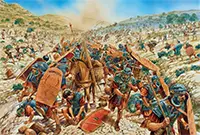The Roman Emperor Hadrian
Hadrian was emperor of Rome in the 2nd Century. He was a popular ruler, with the army and with the populace, and is perhaps most well-known for the wall that he had built in Brittania. 
He was born on Jan. 24, 76, either in Rome or in Italica. (Sources differ.) His father, Aeilus Hardianus Afer, died when the boy was 10. At that time, Hadrian's uncle, Trajan, became the boy's guardian, along with Acilius Attianus. Hadrian did his military training in Italica and then set about pursuing a political career, serving as tribune and then quaestor. Trajan was consul when he went to war against the Dacians, and Hadrian accompanied the army on that campaign, which ended in glorious victory for Rome. In 105, Hadrian won the office of tribune of the plebeians. Continuing up the cursus honorum, he made praetor in 107, served as governor of Lower Pannonia, and then won selection as consul in 108. Back in the army, he was commanding Trajan's rearguard in Cilicia when the emperor died. Even though Trajan had served as Hadrian's guardian and mentor, he hadn't formally adopted the younger man, at least as far as anyone knew. However, Trajan's wife, Pompeia Plotina, had papers of succession that clearly showed such an adoption, and so when Hadrian returned to Rome and announced that the troops in the field had proclaimed him emperor, the Senate agree to validated that claim and Hadrian became the emperor. 
He enacted some legal reform, giving slaves more rights with regard to treatment by their masters and providing for lesser punishment for people facing bankruptcy. He ordered some reconstruction, including rebuilding many buildings damaged by a recent fire. The popularity of Hadrian as the Emperor of Rome can be judged by the sparse amount of palace intrigue while he was away, which was a large part of his reign. He wanted to see the Empire for himself, so he traveled, near and far, to the farthest reaches of Britain, in which he ordered the building of a massive wall, and to the eastern frontiers, to again shore up the defenses there. In contrast to his expansionists predecessor, Hadrian preferred maintaining the gains that Trajan and others had made. 
Hadrian's Wall, as it has come to be known, was just one of many building projects on which Hadrian had the empire embark. On the municipal level, he established cities in Egypt and Greece and Asia Minor and in the Balkans. Athens sported the Arch of Hadrian, completed in 132. (Hadrian was so enchanted with Greece that he gained the name Graeculus ("Greekling") when he was young and then, as an adult, went there more than once and even participated in the Eleusinian Mysteries.) At home in Rome, he threw his considerable influence behind the construction of the Pantheon, itself a new version of an even older temple dating to the days of the Republic. One place in which Hadrian courted some controversy was Jerusalem. He visited that ancient city in 130 and then had it rebuilt the way he wanted it to look, not the way it had looked. He gave the city a Roman name and then built a temple to Jupiter over the ruins of the Jewish Temple, which the legions of All of the travel and especially the grinding nature of ending the Second Jewish Revolt created poor health in Hadrian. He returned to Rome and took to writing poetry in what little spare time he had. He had married Vibia Sabina in 100; they had had no children. He had thought ahead enough to name a successor, the proconsul of Asia Antoninus Pius, who vowed to name as his successors Lucius Verus and Marcus Aurelius. Hadrian died in 138; he was 62. Antoninus Pius did indeed succeed him. |
|
Social Studies for Kids
copyright 2002–2025
David White





